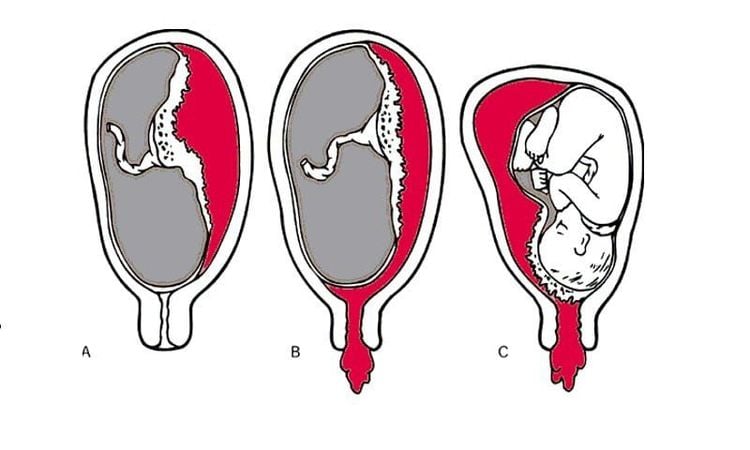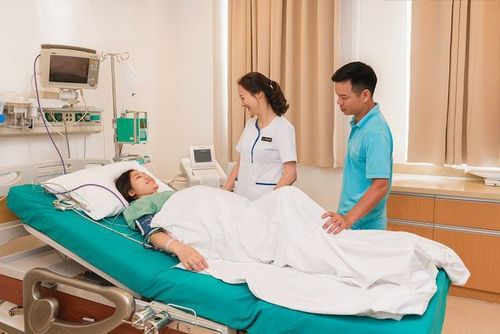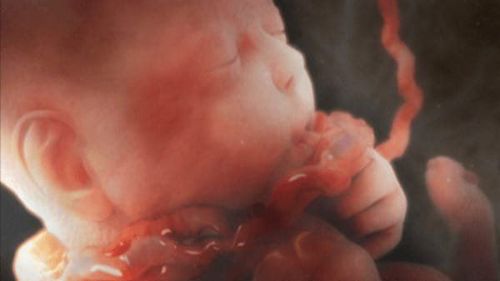This is an automatically translated article.
The article is professionally consulted by Specialist Doctor I Le Thi Phuong - Department of Obstetrics and Gynecology - Vinmec Ha Long International Hospital.
Placental abruption is an obstetric emergency that often occurs in the third trimester of pregnancy with sudden, rapid development that can threaten the life of the mother and the fetus due to hemorrhagic shock, complications of fetal distress, and other complications. coagulopathy or anuria. Early diagnosis and timely treatment are necessary to save the mother and fetus's life.
1. What is a veggie?
Placental abruption is a case where the placenta is stuck in the right position but is soon peeled off before the fetus is delivered, due to the formation of a hematoma behind the placenta. This hematoma grows larger and causes the placenta to detach from the uterine wall, cutting off the nourishment between the mother and the fetus
Placental abruption is a dangerous obstetric complication that needs to be detected early and treated appropriately. protect the health of mother and unborn child.
2. Is the vegetal sprout dangerous?
Placental abruption progresses rapidly, if not handled promptly, it will lead to dangerous complications as follows:
Hemorrhagic shock: shock occurs quickly, especially after the fetus and placenta are delivered. It is important to note that the amount of blood that remains in the uterus can be much more than the amount of blood that flows out of the vagina. Coagulation disorders: due to lack of fibrinogen, found that after the placenta is removed, the thin blood does not clot and continues to flow out of the vagina. This complication is more severe if the progression of placental abruption lasts longer, so it is necessary to detect it early for immediate treatment. Anuria: it is necessary to monitor urine continuously in the first hours and the following days to detect this complication. Patients present with little urine, even no urine, pain in the hip and back, blood urea increased but urinary urea decreased. Anuria is mainly due to shock, causing hypotension and bleeding. Others are caused by irreversible necrosis of the renal cortex, which has a severe prognosis, which can lead to death. In addition, placenta abruption can leave other very dangerous sequelae such as: acute liver and kidney failure, adrenal insufficiency, hypertension, ...
3. Signs of vegetative growth
3.1 Physical symptoms Pain : pain in the lower abdomen comes on suddenly, starting from the uterus and spreading to the back and down the thighs and then spreading to the whole abdomen. The pain is constant and prolonged. When the uterus is as hard as wood, the patient is rolling around in pain, struggling, panicking, showing signs of increasingly severe shock, rapid pulse, low blood pressure, severe cases may be accompanied by pre-eclampsia syndrome.

Bleeding: Vaginal bleeding may or may not be present due to blood remaining in the uterus without draining out. The nature of the bleeding is dark red, thin, non-clotting blood. 3.2 Systemic symptoms The patient has a state of fatigue, excitement due to anemia or fatigue, fainting. Shock occurs quickly although little vaginal bleeding may be seen. The severity of the shock does not correlate with the amount of blood lost to the vagina. Pre-eclampsia may be accompanied by a slight increase in blood pressure at first, then decrease, slow pulse, cold limbs, sweating, pale skin and mucous membranes, ... 3.3 Physical symptoms Spastic uterus is the most important symptom. The uterus is abnormally rigid, the basal tone of the uterus is also higher than normal, in severe cases the uterus is hard as wood. The height of the uterus is increasing, the hematoma is bigger and the height of the uterus is increasing. Palpation of fetal parts through the abdominal wall is difficult due to uterine contractions. Auscultated fetal heart rate changes rapidly or is not heard in severe cases. Mild forms can also be heard but are difficult, often progressing to fetal failure very quickly. Vaginal examination shows that the cervix is tight like a ring, amniotic fluid is bulging, amniotic fluid is mixed with red blood. 3.4 Symptoms of placental abruption according to disease type Depending on the severity of placental abruption (grades I, II, III), the symptoms may be different:
Placenta abruption grade I: there is a phenomenon Mild vaginal bleeding, mild uterine contractions, stable vital signs, and stable fetal heart rate. Blood coagulation tests were normal. Grade II placental abruption: moderate vaginal bleeding, abnormal uterine contractions, low blood pressure, fetal distress, and blood clotting disorders. Placental abruption grade III: is the most severe form. There are heavy vaginal bleeding and strong uterine contractions, very low blood pressure, fetal death, severe coagulopathy.
4. Risk factors for placental abruption
Abortion is common in the following cases:
People who give birth to children, old age (80%) High blood pressure due to gestational toxicity (when pregnant, new blood pressure, never had it before) Due to direct trauma to the abdomen: (due to a traffic accident, falling from a car, or a daily life accident, ...) Due to the needle punctured in the placenta when amniocentesis is not in the right place, it causes bleeding to form a hematoma. After vegetables make sprouts. Due to incorrect technique of surgical rotation, pulling the umbilical cord causing placental abruption In addition, pregnant women who do not have regular antenatal check-ups to detect early the risk of pregnancy toxicity, those with a poor diet, Living in a place with low socio-economic conditions, the higher the chance of abruption. That is why people who do hard and overworked labor, and women who live in remote and isolated areas have a higher risk of placental abruption than in urban areas.

5. Prevention of abortifacients
To avoid the occurrence of placental abruption, which is dangerous for both mother and child, pregnant women should pay attention:
The interval between two births should not last more than 7 years When pregnant, there must be a reasonable lifestyle and rest It is advisable to register for a regular antenatal check-up at a reputable medical facility right after becoming pregnant for advice and management of pregnancy. Supplementing with folic acid before and immediately after pregnancy. Pregnancy Health monitoring is even more important in the last months of pregnancy, pregnant mothers need to perform regular antenatal checkups and listen to their body and the reactions of the fetus. When detecting high-risk factors such as: vaginal bleeding, lower abdominal pain, ... pregnant women should promptly go to the hospital specializing in obstetrics and gynecology for timely diagnosis and treatment.
Currently, Vinmec International General Hospital has mastered the cesarean section technique for pregnant women with obstetric pathologies such as placenta previa, placenta previa, preeclampsia, eclampsia, ... The technique is performed by a team of qualified doctors and supported by modern medical equipment.
Please dial HOTLINE for more information or register for an appointment HERE. Download MyVinmec app to make appointments faster and to manage your bookings easily.














